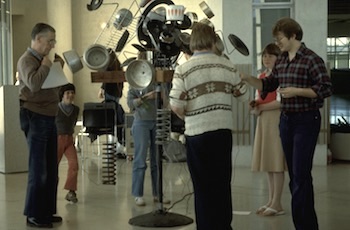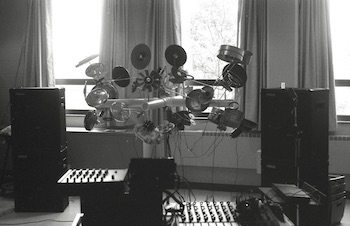 |
||
| Scrapercussion 2024 by Dan Senn |
#7 Feedback Recordings
1989 Five Improvisations on a Sound Sculpture Total duration of about 31 minutes. |
|
| The Scraperussion #7 Feedback Recordings
1989, 1991 were recorded on June 6, 1989 while the student led
Tiananman Square protests and massacre were occuring. As a closer
observer of international politics I was keenly aware of this event
causing me to name one of the improvs made that day after the event
(not included here for technical problems). The recording took place in
the Fine Artis Computer Lab I had designed and taught out of as an
Associate Professor of Music and Lab Coordinator, the students absent, away on summer break. The banner photo above (click for
clarity) was taken on the day of the recording session, one that included these
feedback improvs and a set of acoustic performances. An Associate Professor at Ball State University, I was committed to teaching interdisciplinary art as applied to emerging digital technologies, I was first an artist. Communication with students was important and improved through personal growth and individuation. These soundsculptures, and I built 10, #7 now in the Sylvia Smith Archive at the University of Akron, were exceptional that interarts research was viewed with deep suspicion—Cleve Scott and Larry Graham brave exceptions. The scrapercussions were by nature problematic as they were concieved as 1) sculptures to be seen and not heard, 2) instruments to be heard and not seen, and 3) mobile dance "partners" to be pushed, pulled, flung throughout the dance space, interacted with by dancers and patrons alike. In an early outing at the Links Gallery in Canberra, Australia (I was then a Lecturer I in Electronic Music Composition at the Canberra School of Music), these also acted as the antenna for a Theremin sensing the proximity of patrons. It wasn't until about 1987, while in Muncie, IN, that I discovered their role as feedback instruments in live performance. The Scrapercussions are comprised of found resonant, metal objects from garage sales and thrift stores. Each item, or resonator, is chosen for sonic qualities when tapped (an embarrassment to my kids while so shopping) but also for shape, and, at times, social function. These (see detail) are "suspended" around and through a pvc chassis using 1/4" rods that were threaded on end to form a metallic continuum where the PVC chassis acts passively. When striking a resonator, or rod connector, in this continuum is to hear a composite, sonic identity for that sound sculpture representing, paradoxically, the planned, interdisciplinary essence of the instrument. In these instruments, this fact is not a bland byproduct but a facilitating necessity as visual, sonic and symbolic features (i.e. a shot cup) spin in multiple, inter-related directions. It is this considerateness that spurs the anthropomorphisms that flow from scraperussion from dancers. While in fun, all this, it is an irony that confuses others stuck in the eight bar phrase. And the continuums essential to this system that are key to the effectiveness of scrapercssions as a feedback source as demonstrated in this web page. |
Click titles to hear works. Use headphones or large sound system. Shot Cup (5'35") uses one piezo attached to a double sided booze measuring cup visible in the following photo. Beep Boop (1'07") and Beep Boop (1'14") uses multiple piezo mics, I do not exactly remember. For Ms Margaret (4'49") uses multiple piezo mics, I still do not exactly remember. Before Roulette (18'52") was a rehearsal patch for a show at Roulette Intermedium in New York City that uses 6 piezo inputs. Years later I applied it as the sound track for my video "Frances". NOTE: You may want to attenuate some of these (start at 50%) recordings re-engineered in April of 2024, at Studio FMEra in Watertown, WI, USA. While teaching in Australia, 1980-84, working with the first 6 Scrapercussions, I wished to amplify them using contact microphones but these were quite expensive. Back in the US, years later at BSU, I discovered inexpensive piezo transducers used by some fluxus artists like Paul Panhuysen. I had become acquainted with many fluxus artists, especially in Europe, assisted by Phill Niblock in New York City. Richard Lerman sent me preamp circuit diagrams that I integrated into my existing scrapercussions and instruments to come. Click to enlarge.  Dan Senn directing an audience participation work at the High Court in Canberra, Australia, 1983. Photo by Tim Brooke. About this time, I had learned of contact speakers through the work of Alvin Lucier, a seminal fluxus artist of extraordinary wit and invention, who visited my Canberra Studio in March of 1984. Here is a telling review and photo of Lucier's concert on that visit. Contact speakers consist of a speaker magnet without the paper diaphram. Puchasing two of these, I bolted them to stationary positions on Scrapercussion #7, clipped my specially designed, moveable piezos to various resonators to effect feedback loop that included a small amplifier. Switched on, I found myself in the presence of a very distinct, even exquisite feedback loop. To control of the loop, and keep external speakers from blowing up, I inserted a limiter into the circuit with sounds produced dependent on the scrap resonator the piezo was attached to. |
Further enhancing this, I then included
an older small 4-Channel Tascam mixer (see photo below) that enabled connecting as many as 6 piezos
to the loop as in "Before Roulette". The Scrapercussion #7 as a feedback instrument was thus performed by
attaching 1 to 6 piezo mics to various resonators, testing each for
sonic possibilities and then playing the instrument by simply raising
the six faders on the mixer, mixing one resonator mic with another, fading between
mics, etc. While stunningly powerful, this simple patch on a complex interdisciplinary
instrument so conceived, was joyously unwieldly.
The analog gear was inherently
unstable to begin with. An advantage. The slightest shift in piezo
location on a resonator or
a shift room temperature provided a vastly different result. It was
necessary to learned the instrument, to rehearse, but repeatable
results were impossible as was only 1-2 steps ahead of the audience in
a universe of barely in control. And yet, as I was accustomed to making
and firing Raku pottery where unstable condition
were planned and desirable, this was OK even if difficult to explain to a
University Music Department in Indiana that believed dodecaphony a
crime. In the feedback mode, performances of Scraperussion#7 were like riding a bronco with every improvisation a unique real-time discovery over a rough sonic terrain. DS 041024 Dan Senn (Prague-Watertown) is an intermedia artist working in music composition and production, kinetic sound sculpture, experimental and documentary film. He has been a professor of music and art in the United States and Australia and travels internationally as a lecturer, performer and installation artist. He lives in Prague where he directs the Echofluxx festivals, and Watertown, Wisconsin, the USA, with his partner-collaborator, Caroline Senn. Dan's work moves freely between expressive extremes and languages depending upon the aesthetic joust at hand. Dan is cofounder of Roulette Intermedium in New York City, Cascadia Composers of Portland Oregon, and the Echofluxx media festivals in Prague. (read more). Click to enlarge.
 Feedback recording setup 1989.
|